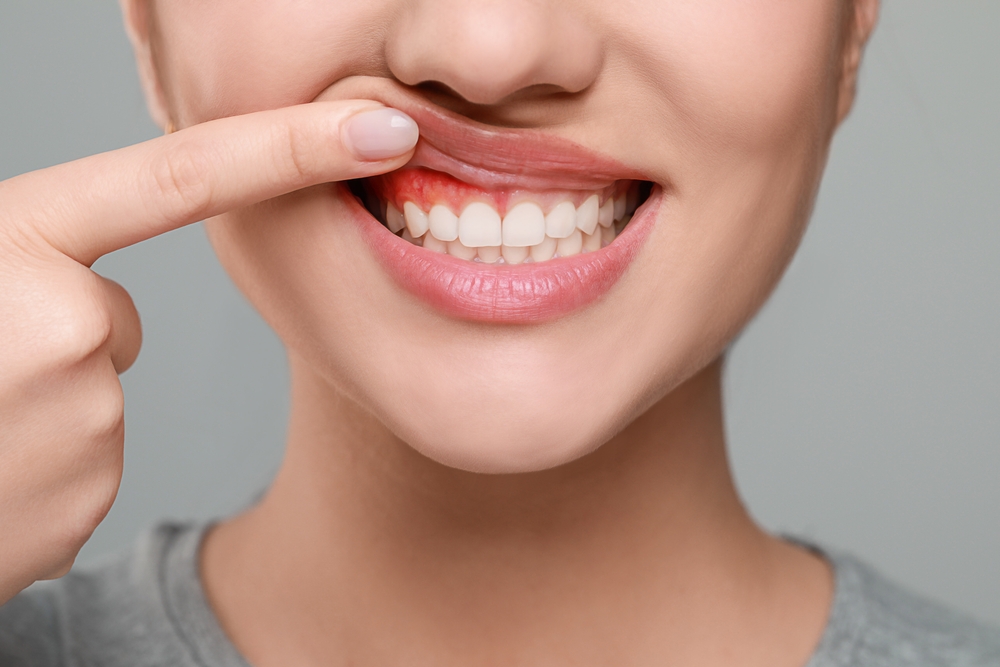Has anyone ever wondered what it would be like to smile confidently without worrying about bad breath from gum disease symptoms?
Or how about enjoying your favorite foods without the discomfort of sensitive gums?
Well, you’re not alone!
Nearly half (47.2%) of adults aged 30 and over are affected by some form of gum disease. That’s a lot of people. So, spot your sign as early as possible and take action.
Don’t Ignore the Signs: How to Spot Gum Disease Early
Neglecting gum disease could result in serious conditions. That’s why understanding the symptoms would be the key to protecting your oral health. Gum disease is not only a matter of not bleeding—it does considerable damage to your gums and teeth.
Gum disease has two stages: gingivitis and periodontitis. When you have gingivitis, your gums will be red, swollen and may easily bleed when they are touched. With proper dental care, this stage can often be reversed. However, if there is gingivitis it could progress to periodontitis which is very advanced and involves gum recession, bone destruction and even tooth loss.
Think you might have gum disease? Here’s what to look for:
How Does Gum Disease Develop?
It might sound a bit unsettling, but your mouth hosts a large number of bacteria every day. However, the good news is that not all bacteria are harmful. Nevertheless, things can get out of hand when the detrimental organisms begin reproducing uncontrollably. These bacteria produce a sticky film on your teeth and gums called plaque.
Brushing regularly is important as plaque forms continuously. If you do not brush your teeth, more plaque will build up, causing gingivitis and periodontitis.
The real problem begins when this plaque lingers around for too long. It eventually turns into tartar which settles under the gum line that cannot be reached by floss and toothbrush. Once there is tartar, it causes increased multiplication of bacteria that attack and break down the soft tissues surrounding the teeth to foster gum diseases.
Gum Disease Symptoms: Understanding Gingivitis and Periodontitis
Gum disease usually presents in two forms; principally, gingivitis and periodontitis. However, they differ in terms of their stages and signs such as gingivitis may turn to periodontitis when it remains untreated.
Symptoms of Gingivitis
It is actually the first and most minor stage of gum disease. Many people do not even realize that they are infected with it because gingivitis mostly doesn’t cause pain. Nevertheless, identifying these symptoms can avert it from developing into periodontitis:
- Bleeding gums after brushing or flossing.
- Discoloration of the gums (red, purple, or white).
- Swollen or inflamed gums that are tender to the touch.
- Gum abscess, a painful, pus-filled swelling.
- Persistent bad breath despite regular oral hygiene.
- Gums that recede slightly or pull away from the teeth.
- Soft, spongy gums that feel different from usual.
Symptoms of Periodontitis
Periodontitis is a severe infection of the gums, and when you do not receive treatment for it, it will result in tooth loss, among other severe health problems. This stage of gum disease usually causes a lot of damage to the soft tissues and bone. Key symptoms include:
- Receding gums expose the tooth roots.
- Sensitive teeth, especially when eating hot or cold foods and drinks.
- Loose teeth or a noticeable change in bite alignment.
- Bad breath.
- Black gums, indicating a severe infection.
- Pus between the teeth and gums.
- Teeth that appear to lengthen as gums recede.
- Pain when chewing due to tooth and gum sensitivity.
- Spaces form between teeth as gums and bone deteriorate.
Risk Factors Linked with Gum Disease
Gum disease risk may rise for a number of reasons. It is of major importance to be familiar with the connection between your daily lifestyle and the general well-being of your body. You can be at a greater risk if you suffer from one of the diseases or have these features, which are symptoms of the disease.
- Poor oral hygiene
- Smoking or tobacco use
- Diabetes
- Hormonal changes
- Medications
- Genetics
- Nutritional deficiencies
- Chronic stress
- Obesity
- Teeth grinding or clenching
- Age
- Alcohol consumption
- Crooked teeth
- Poor-fitting dental restorations
Gum Disease Treatments
At our clinic, our Grand Prairie dentist, Dr. K, has many different treatments for gum diseases that are designed to suit your specific needs and produce the best results.
Simple Dental Cleaning:
This is your go-to for routine maintenance and to prevent gum disease at the beginning stage. It gets rid of plaque and surface tartar, keeping the gums healthy. This method works especially well in early-stage gum disease and is important for overall oral health.
Deep Cleaning (Scaling and Root Planing):
Once gum disease progresses past its earliest stages, a deeper approach is required. Deepest cleaning or scaling and root planing extracts plaque as well as calculus below the gums. These measures lessen inflammation hence halting any further spread of infection. At this stage, it becomes rather helpful for those who exhibit first signs of periodontitis since it makes tooth roots smoother thereby making it more difficult for bacteria to reattach themselves.
Deep Cleaning with Laser and Irrigants:
More advanced gum infections call for methods like deep laser cleaning along with medicated irrigants. The laser goes into areas which cannot be reached by conventional tools thus killing bacteria deeply seated within the gum tissue. Also, healing occurs faster when using this technique because it prompts growth of healthy gingiva involved in disinfection too. In case you have a severe case of periodontitis then consider going by this method instead of others.
Act Now For Better Gum Health!
At Grand Prairie Family Dental, we are aware of the fact that dealing with gum disease may be very irritating and tiresome to you. You would like to have healthy teeth and gum pain remain far away but at the same time, you cannot decide the proper treatment which suits you.
We believe that everyone needs to get the best, clear and personal care for their teeth. We perfectly understand how much gum disease has potential to damage your health in future. That’s why our team, led by experienced dental professionals like Dr. Behrooz Khademazad, is here to give you expert direction that fits your specific kind of situation.
Here’s how we do it:
- Thorough Assessment: We start with a comprehensive evaluation of your gum health to understand the severity of your condition.
- Customized Treatment Plan: We design a plan that suits your needs and focuses primarily on your gum disease, a concern for that plan, along with your ways of living and the budget you can afford.
- Ongoing Care: Right from your first treatment to getting regular checkups, we make sure you stick to the prescribed routine to keep your gums in good shape.
Don’t wait until gum disease starts affecting your overall health. Schedule an appointment with the best dentist in Grand Prairie Tx, Dr. Khademazad, today and take the first step towards better oral health. The sooner you act, the sooner you can enjoy a life free from gum disease discomfort. Get In Touch With Us: 972-988-0900
Schedule a consultation today.
FAQs
1. What are signs of serious gum disease?
Signs of serious gum disease are : receding gums, loose teeth, persistent bad breath, and pus between the teeth and gums.
2. What is the early stage of gum disease?
Gingivitis is the early stage, characterized by red, swollen, and bleeding gums.
3. Can gum disease be treated?
Yes, gum disease can be treated with professional cleanings, scaling, root planing, and, in advanced cases, surgery.
4. Can gum disease make you sick?
Yes, untreated gum disease can lead to infections that may affect overall health, including heart disease and diabetes.
5. Can gum disease repair itself?
No, gum disease does not repair itself; it requires professional treatment and proper oral hygiene.
Grand Prairie Family Dentistry
Contact Us
Phone:
972-988-0900 (office)
Address:
2475 W Pioneer Pkwy
Grand Prairie, Texas, 75051









